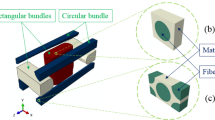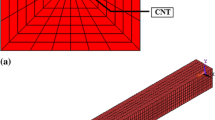Abstract
This paper deals with the thermal analysis of carbon nanotube (CNT) based composites by meshless element free Galerkin method. Cylindrical representative volume element (cylindrical RVE) has been chosen to evaluate the thermal properties of nano-composites using multi-domain and simplified approaches. The values of temperature have been calculated at different points and plotted against RVE length and RVE radius. A sensitivity analysis of RVE as well as CNT dimensions has been carried out in detail. The present computations show that the equivalent thermal conductivity is a function of CNT length, CNT radius, RVE length and RVE radius. Based on present numerical simulations, an approximate formula is proposed to calculate the equivalent thermal conductivity of nano-composites. The results obtained by simplified approach have been found in good agreement with those obtained by multi-domain approach.
Similar content being viewed by others
Abbreviations
- k m_1 :
-
thermal conductivity of matrix (W/m K)
- k m_2 :
-
thermal conductivity of carbon nanotube (W/m K)
- k e :
-
equivalent thermal conductivity of composite (W/m K)
- L :
-
length of cylindrical RVE (nm)
- L c :
-
CNT length (nm)
- m :
-
number of terms in the basis
- m 1 :
-
matrix material
- m 2 :
-
carbon nanotube material
- n :
-
number of nodes in the domain of influence
- n′:
-
outward normal to the surface
- q :
-
heat flux (W/m2)
- r o :
-
outer radius of CNT (nm)
- R o :
-
radius of cylindrical RVE (nm)
- t :
-
thickness of CNT (nm)
- T C :
-
constant temperature at CNT surface (K)
- \(T^{h}({\mathbf{r}})\) :
-
MLS approximation function for temperature
- w :
-
weight function used in MLS approximation
- \(\bar{w}\) :
-
weighting function used in weak form
- α:
-
penalty parameter
- Γ 3 :
-
CNT surface
- Γ:
-
boundary of the domain
- Ω 1 :
-
domain for matrix
- Ω 2 :
-
domain for CNT
- \(\Phi _{I} ({\mathbf{r}})\) :
-
shape function
References
Thostensona ET, Renb Z, Chou TW (2001) Advances in the science and technology of carbon nanotubes and their composites: a review. Composites Sci Technol 61:1899–1912
Dai H (2002) Carbon nanotubes: opportunities and challenges. Surface Sci 500:218–241
Bernholc J, Brenner D, Buongiorno Nardelli M, Meunier V, (2002) Mechanical and electrical properties of nanotubes. Ann Rev Mater Res 32:347–375
Qian D, Wagner GJ, Liu WK, Yu MF, Ruoff RS (2002) Mechanics of carbon nanotubes. Appl Mech Rev 55:495–532
Breuer O, Sundararaj U (2004) Big returns from small fibers: a review of polymer/carbon nanotube composites. Polym 25:630–645
Popov VN (2004) Carbon nanotubes: properties and application. Mater Sci Eng R Rep 43:61–102
Harris PJF (2004) Carbon nanotube composites. Int Mater Rev 49:31–43
Rafii-Tabar H (2004) Computational modelling of thermo-mechanical and transport properties of carbon nanotubes. Phy Rep 390:235–452
Shen S, Atluri SN (2004) Computational nano-mechanics and multi-scale simulation. Comput Mater Continua 1:59–90
Khare R, Bose S (2005) Carbon nanotube based composites- a review. J Miner Mater Characterization Eng 4:31–46
Treacy MMJ, Ebbesen TW, Gibson JM (1996) Exceptionally high Young’s modulus observed for individual carbon nanotubes. Nature 381:678–680
Krishnan A, Dujardin E, Ebbesen TW, Yianilos PN, Treacy MMJ (1998) Young’s modulus of single-walled nanotubes. Phys Rev B 58:14013–14019
Salvetat JP, Briggs GAD, Bonard JM, Bacsa RR, Kulik AJ, Stöckli T, Burnham NA, Forr’o L (1999) Elastic and shear moduli of single-walled carbon nanotube ropes. Phys Rev Lett 82:944–947
Salvetat JP, Kulik AJ, Bonard JM, Briggs GAD, Stöckli T, M’et’enier K, Bonnamy S, B’eguin F, Burnham NA, Forr’o L (1999) Elastic modulus of ordered and disordered multiwalled carbon nanotubes. Adv Mater 11:161–165
Salvetat JP, Bonard JM, Thomson NH, Kulik AJ, Forro L, Benoit W, Zuppiroli L (1999) Mechanical properties of carbon nanotubes. Appl Phys A 69:255–260
Jia Z, Wang Z, Xu C, Liang J, Wei B, Wu D, Zhu S (1999) Study on poly (methyl methacrylate): carbon nanotube composites. Mater Sci Eng A 271:395–400
Xie S, Li W, Pan Z, Chang B, Sun L (2000) Mechanical and physical properties on carbon nanotube. J Phys Chem Solids 61:1153–1158
Allaouia A, Baia S, Chengb HM, Bai JB (2002) Mechanical and electrical properties of a MWNT/epoxy composite. Composite Sci Technol 62:1993–1998
Hayashida T, Pan L, Nakayama Y (2002) Mechanical and electrical properties of carbon tubule nanocoils. Physica B 323:352–353
Frogley MD, Ravich D, Wagner HD (2003) Mechanical properties of carbon nanoparticle-reinforced elastomers. Composites Sci Technol 63:1647–1654
Jiang X, Bin Y, Matsuo M (2005) Electrical and mechanical properties of polyimide–carbon nanotubes composites fabricated by in situ polymerization. Polymer 46:7418–7424
Xiaoqing Gao, Lang Liu, Guo Q, Shi J, Zhai G (2005) Fabrication and mechanical/conductive properties of multi-walled carbon nanotube (MWNT) reinforced carbon matrix composites. Mater Lett 59:3062–3065
Feng Y, Yuan HL, Zhang M (2005) Fabrication and properties of silver-matrix composites reinforced by carbon nanotubes. Mater Characterization 55:211–218
McNallya T, Pötschkeb P, Halleyc P, Murphyc M, Martinc D, Belld SEJ, Brennane GP, Beinf D, Lemoineg P, Quinn PJ (2005) Polyethylene multiwalled carbon nanotube composites. Polymer 46:8222–8232
Yamamoto G, Sato Y, Takahashi T, Omori M, Okubo A, Tohji K, Hashida T (2006) Mechanical properties of binder-free single-walled carbon nanotube solids. Scripta Mater 54:299–303
Yakobson BI, Brabec CJ, Bernholc J (1996) Nanomechanics of Carbon Tubes: Instabilities beyond Linear Response. Phys Rev Lett 76:2511–2514
Cornwell CF, Wille LT (1997) Elastic properties of single-walled carbon nanotubes in compression. Solid State Commun 101:549–642
Hernández E, Goze C, Bernier P, Rubio A (1998) Elastic properties of C and B x C y N z composite nanotubes. Phys Rev Lett 80:4502–4505
Sánchez-Portal D, Artacho E, Soler JM, Rubio A, Ordejón P (1999) Ab initio structural, elastic, and vibrational properties of carbon nanotubes. Phys Rev B 59:12678–12688
Buongiorno Nardelli M, Fattebert J-L, Orlikowski D, Roland C, Zhao Q, Bernholc J (2000) Mechanical properties, defects and electronic behavior of carbon nanotubes. Carbon 38:1703–1711
Froudakis GE (2001) Hydrogen interaction with single-walled carbon nanotubes: a combined quantum-mechanics/molecular-mechanics study. Nano Lett 1:179–182
Guo Y, Guo W (2003) Mechanical and electrostatic properties of carbon nanotubes under tensile loading and electric field. J Phys D Appl Phys 36:805–811
Williams KA, Eklund PC (2000) Monte Carlo simulations of 2 physisorption in finite-diameter carbon nanotube ropes. Chem Phys Lett 320:352–358
Levesque D, Gicquel A, Darkrim FL, Kayiran SB (2002) Monte Carlo simulations of hydrogen storage in carbon nanotubes. J Phys: Condens Matter 14:9285–9293
Hasan S, Guo J, Vaidyanathan M, Alam MA, Lundstrom M (2004) Monte-Carlo simulation of carbon nanotube devices. IEEE-International Workshop on Computational Electronics, October 24–27, 2004, Purdue University, West Lafayette, Indiana, USA
Yao N, Lordi V (1998) Young’s modulus of single-walled carbon nanotubes. J Appl Phys 84:1939–1943
Jin Y, Yuan FG (2003) Simulation of elastic properties of single-walled carbon nanotubes. Composite Sci Technol 63:1507–1515
Chang T, Gao H (2003) Size-dependent elastic properties of a single-walled carbon nanotube via a molecular mechanics model. J Mech Phys Solids 51:1059–1074
Liew KM, He XQ, Wong CH (2004) On the study of elastic and plastic properties of multi-walled carbon nanotubes under axial tension using molecular dynamics simulation. Acta Mater 52:2521–2527
Liew KM, Wong CH, Tan MJ (2006) Tensile and compressive properties of carbon nanotube bundles. Acta Mater 54:225–231
Wong EW, Sheehan PE, Lieber CM (1997) Nanobeam mechanics: elasticity, strength, and toughness of nanorods and nanotubes. Science 277:1971–1975
Sohlberg K, Sumpter BG, Tuzun RE, Noid DW (1998) Continuum methods of mechanics as a simplified approach to structural engineering of nanostructures. Nanotechnology 9:30–36
Govindjee S, Sackman JL (1999) On the use of continuum mechanics to estimate the properties of nanotubes. Solid State Commun 110:227–230
Ru CQ (2000) Column buckling of multiwalled carbon nanotubes with interlayer radial displacements. Phys Rev B 62:16962–16967
Srivastava D, Menon M, Cho K (2001) Computational nanotechnology with carbon nanotubes and fullerenes. Comput Sci Eng 3:42–55
Harik VM (2002) Mechanics of carbon nanotubes: applicability of the continuum-beam models. Comput Mater Sci 24:328–342
Liu YJ, Chen XL (2003) Continuum models of carbon nanotube-based composites by the BEM. Electr J Boundary Elem 1:316–335
Liu YJ, Chen XL (2003) Evaluations of the effective materials properties of carbon nanotube-based composites using a nanoscale representative volume element. Mech Mater 35:69–81
Chen XL, Liu YJ (2004) Square representative volume elements for evaluating the effective material properties of carbon nanotube-based composites. Comput Mater Sci 29:1–11
Xiao T, Liao K (2004) A nonlinear pullout model for unidirectional carbon nanotube-reinforced composites. Composite Part B 35:211–217
Wang XY, Wang X (2004) Numerical simulation for bending modulus of carbon nanotubes and some explanations for experiment. Composite Part B 35:79–86
Liu Y, Nishimura N, Otani Y (2005) Large-scale modeling of carbon-nanotube composites by fast multipole boundary element method. Comput Mater Sci 34:173–187
Kireitseu M, Kompis V, Altenbach H, Bochkareva V, Hui D, S (2005) Continuum mechanics approach and computational modelling of submicrocrystalline and nanoscale materials. Fullerenes Nanotubes Carbon Nanostruct 13:313–329
Tserpesa KI, Papanikos P (2005) Finite element modeling of single-walled carbon nanotubes. Composite Part B 36:468–477
Ashrafi B, Hubert P (2006) Modeling the elastic properties of carbon nanotube array/polymer composites. Composite Sci Technol 66:387–396
Hone J, Whitney M, Piskoti C, Zettl A (1999) Thermal conductivity of single walled nanotubes. Phys Rev B 59:2514–2516
Yi W, Lu L, Dian-lin Z, Pan ZW, Xie SS (1999) Linear specific heat of carbon nanotubes. Physical Review B 59:9015–9018
Kim P, Shi L, Majumdar A, McEuen PL (2001) Thermal transport measurement of individual multiwalled nanotubes. Phys Rev Lett 87:215502 (1–4)
Berber S, Kwon YK, Tomanek D (2000) Unsually high thermal conductivity of carbon nanotubes. Phys Rev Lett 84:4613–4616
Osman MA, Srivastava D (2001) Temperature dependence of the thermal conductivity of single walled carbon nanotube. Nanotechnol 12:21–24
Che J, Cagin T, Goddard III WA (2001) Thermal conductivity of carbon nanotubes. Nanotechnology 11:65–69
Biercuk MJ, Llaguno MC, Radosavljevic M, Hyun JK, Johnson AT, Fischer JE (2002) Carbon nanotube composites for thermal management. Appl Phys Lett 80:2767–2769
Maruyama S (2003) A molecular dynamics simulation of heat conduction of a finite length single-walled carbon nanotube. Microscale Thermophys Eng 7:41–50
Moreland JF, Freund JB, Chen G (2004) The disparate thermal conductivity of carbon nanotubes and diamond nanowires studied by atomistic simulation. Microscale Thermophys Eng 8:61–69
Xu Y, Ray G, Abdel-Magid B (2006) Thermal behavior of single-walled carbon nanotube polymer-matrix composites. Composite Part A (in press)
Nishimura N, Liu YJ (2004) Thermal analysis of carbon-nanotube composites using a rigid-line inclusion model by the boundary integral equation method. Comput Mech 35:1–10
Zhang J, Masa. Tanaka, Matsumoto T, Guzik A (2004) Heat conduction analysis in bodies containing thin walled structures by means of hybrid BNM with an application to CNT-based composites. JSME Int J 47:181–188
Zhang J, Masa. Tanaka, Matsumoto T (2004) A simplified approach for heat conduction analysis of CNT-based nano composites. Comput Meth Appl Mech Eng 193:5597–5609
Masa. Tanaka, Zhang J, Matsumoto T (2003) Multi-domain hybrid BNM for predicting thermal properties of CNT composites. Asia-Pacific International Conference on Computational Methods in Engineering 5–7 November, Sapporo, Japan, pp 3–12
Singh IV., Sandeep K, Prakash R (2004) Application of meshless element free Galerkin method in two-dimensional heat conduction problems. Comput Assist Mech Eng Sci 11:265–274
Singh IV. (2004) Meshless EFG method in 3-D heat transfer problems: a numerical comparison, cost and error analysis. Numer Heat Transfer Part A 46:192–220
Singh IV. (2005) A numerical study of weight functions, scaling and penalty parameters for heat transfer applications. Numer Heat Transfer Part A 47:1025–1053
Author information
Authors and Affiliations
Corresponding author
Rights and permissions
About this article
Cite this article
Singh, I.V., Tanaka, M. & Endo, M. Thermal Analysis of CNT-Based Nano-Composites by Element Free Galerkin Method. Comput Mech 39, 719–728 (2007). https://doi.org/10.1007/s00466-006-0061-x
Received:
Accepted:
Published:
Issue Date:
DOI: https://doi.org/10.1007/s00466-006-0061-x




